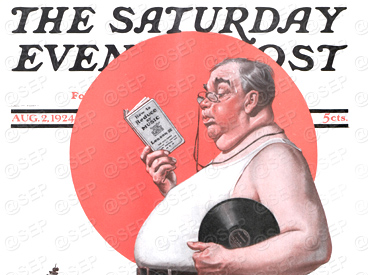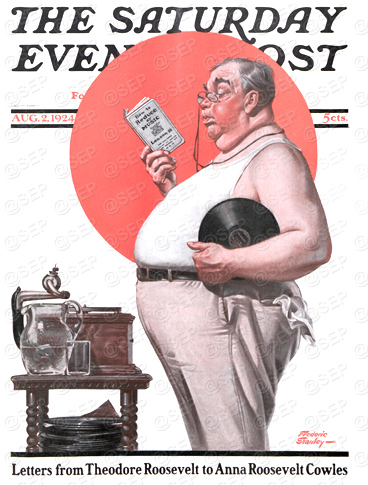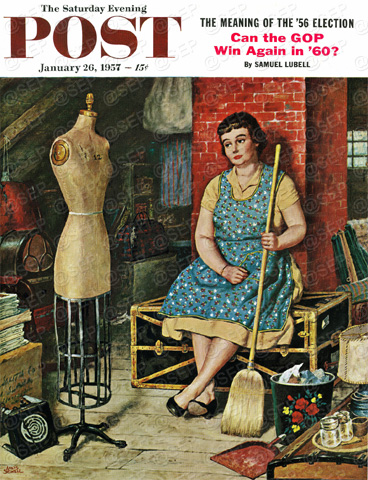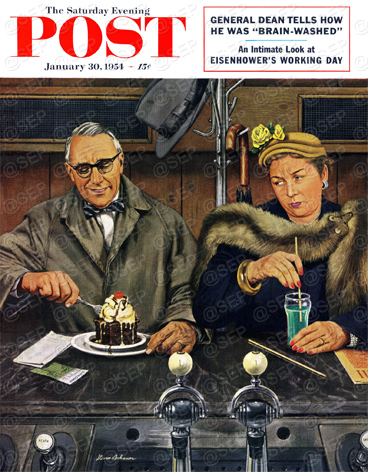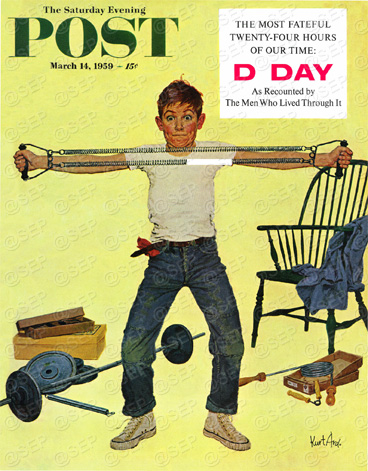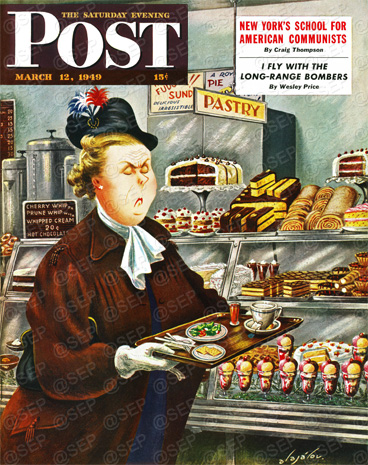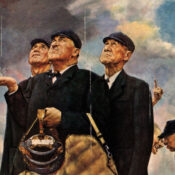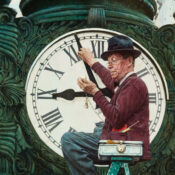Around 45 percent of Americans make New Year’s resolutions. And No. 1 on the list? Lose weight! But as celebrated Post covers over the years show us, this is nothing new.
Reduce to Music
Reduce to Music
Frederic Stanley
August 2, 1924
Reduce to Music was the third of 17 covers Frederic Stanley (1892-1967) created for the Post. But his work might never have come to fruition if the self-taught artist hadn’t been willing to take a big risk.
Young Stanley, who worked as a mechanic by trade and created art in his free time, carried some of his paintings to New York with an ultimatum attached: If the paintings sold, he would devote his life to art; if they didn’t, he would remain a mechanic at his brother’s Massachusetts Buick agency. As it turned out, his brother soon had to post a vacancy. Not only did Stanley sell his work, he returned home with a contract for three more pieces.
In the mid-1940s, Stanley took a break from his successful career to recover from meningitis. Penicillin—only recently available to the public—saved his life, but the illness took its toll, and for a year he made no attempts to paint. When he returned to his canvas, he focused on portraiture of prominent citizens. His first client was H. Nelson Jackson, a wealthy physician, who along with Sewall K. Crocker became the first men to drive an automobile across the United States in 1903. Stanley was working on his final portrait of the Governor of Florida at the time of his death.
Former Figure
Former Figure
Amos Sewell
January 26, 1957
“Ah, the lighthearted, light everything-else years when Mrs. Portleigh was constructed like that!” wrote Post editors of this unforgettable 1957 cover. Since the editorial staff enjoyed noting foibles of cover illustrators, they added that artist Amos Sewell (1901-1983) “borrowed that dress form in Westport, Connecticut, and walked to his car with it under his arm, and nobody gave him the raspberry. In artist colonies people evidently become shockproof.”
At the time San Francisco-born Sewell painted this cover, he had been living in New York for more than 27 years. But he certainly took the long way from San Francisco to arrive in the Big Apple: via the Panama Canal, he worked on a lumber boat to pay his way to the big city where he would launch his career as a commercial artist. After arriving in New York, he studied at the Art Students League and at the Grand Central School of Art under renowned artist and instructor, Harvey Dunn.
Sewell produced hundreds of story illustrations for the Post and its sister publication, The Country Gentleman, often depicting children. Beginning in 1949, he did 45 Post covers until 1962, when the magazine turned to mostly photographic covers.
Soda Fountain Dieter
Soda Fountain Dieter
Stevan Dohanos
January 30, 1954
The life of Stevan Dohanos (1907-1944), the artist of this 1954 cover, reads like a classic American rags-to-riches success story. He was born third of nine children to Hungarian immigrants, and worked an odd number of jobs before settling into the steel mill where his father was employed.
In fact, it was at the steel mill where he began selling crayon-colored copies of famous artists’ work to fellow employees for $2 to $3 a piece. Copies of Norman Rockwell’s early Post covers quickly became his best sellers. Later Dohanos reflected on that time in his autobiography American Realist: “I did not know then that years later I would produce art for the famous Saturday Evening Post and Rockwell would become a personal friend.” Nor had he dreamed that, like Rockwell, he would become one of America’s most successful illustrators.
Working Out
Working Out
Kurt Ard
March 14, 1959
“Every boy has a spell of yearning to resemble Hercules or Tarzan or some other bulging being,” wrote Post editors of this 1959 cover. “To accomplish this he yearns for fairly expensive gadgets, scorning his father’s theory that a superb body can be built with a snow shovel or a spade. … Kurt Ard purchased those awesome exercisers, but you needn’t feel sorry for his model—the expanded springs were fastened to the studio walls and all the lad had to exercise was his face.”
According to the editors, Danish artist Kurt Ard (1925-present) sought modeling volunteers “in the streets, parks, or by posting ads in the papers—and one day a lovely girl named Ulla answered an ad. She became his best model, then his best girl, then his wife.”
Working Out was one of seven covers Ard created for the Post. He sold his first magazine illustration in Scandinavia for $1.43 when he was 17. By age 31, he had more than 1,000 illustrations in Europe’s top-flight magazines.
No Desserts
No Desserts
Constantin Alajalov
March 12, 1949
Russian-born artist Constantin Alajálov (1900-1987) was discussing cover ideas with a Post staffer while dining in a New York restaurant: “I was thinking of doing one about a stout lady in a cafeteria,” Alajálov said. “She’s on a strict reducing diet, see, and she has to carry her tray past a long line of fancy desserts.”
From concept to reality. The result of that dinner conversation was this entertaining 1949 cover accompanied by an amusing quip from the editors: “The plight of the stout lady is agonizing indeed, but not much more so than that of our representative as he ate with Alajálov that night. Our man was on a diet, and Alajálov is one of those slim people who can eat their way through the richest dishes on a menu without ever gaining a pound.”
Considering how brilliant and lighthearted Alajálov’s covers are, you may find it hard to believe that the illustrator began as a government artist, painting huge propaganda portraits and posters during the Russian Revolution. By age 21, he had made his way to Constantinople—at the time a refugee haven—where he sketched portraits in bars and created murals for nightclubs, managing to save enough money to pay his way to America in 1923. In New York, he was still painting murals, until he landed his first New Yorker cover and shortly after the first of many for the Post.
Become a Saturday Evening Post member and enjoy unlimited access. Subscribe now
